ERS Charts of Note
Subscribe to get highlights from our current and past research, Monday through Friday, or see our privacy policy.
Get the latest charts via email, or on our mobile app for  and
and 

Friday, August 21, 2020
USDA administers 15 domestic food and nutrition assistance programs that together form a nutritional safety net for millions of children and low-income adults. Federal expenditures on these programs totaled $92.4 billion in fiscal year (FY) 2019, their lowest level since FY 2009 and 22 percent less than the inflation-adjusted historical high of $117.9 billion set in FY 2013. The decline in spending between 2013 and 2019 was likely largely due to continued improvement in the U.S. economy, as the unemployment rate declined from 7.4 to 3.7 percent over that time period. Spending for the Supplemental Nutrition Assistance Program (SNAP), which accounted for almost two-thirds (65.3 percent) of Federal food and nutrition assistance spending in FY 2019, totaled $60.4 billion, or 8 percent less than in FY 2018 and 30 percent less than the inflation-adjusted historical high of $86.3 billion set in FY 2013. Expenditures fell for both SNAP and the Special Supplemental Nutrition Program for Women, Infants, and Children (WIC) between FYs 2018 and 2019, but increased between 2 and 3 percent for each of the three largest child nutrition programs—the National School Lunch Program, the School Breakfast Program, and the Child and Adult Care Food Program. A version of this chart appears in the Economic Research Service report, The Food Assistance Landscape: Fiscal Year 2019 Annual Report, July 2020.
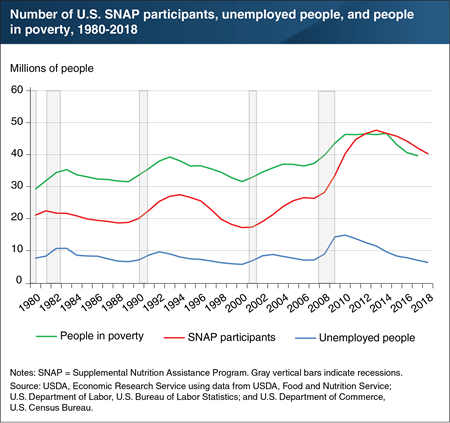
Wednesday, May 13, 2020
USDA’s Supplemental Nutrition Assistance Program (SNAP) is the Nation’s largest food and nutrition assistance program. SNAP is available to most needy households with limited incomes and assets, subject to certain work and immigration status requirements. As a means-tested program, the number of people eligible for SNAP is inherently linked to the health of the economy, making it one of the Nation’s primary countercyclical assistance programs—contracting during periods of economic growth and expanding during economic downturns. National statistics from 1980 to 2018 on employment, poverty, and SNAP participation provide historical context for current U.S. economic conditions. Historical statistics reveal that the number of SNAP participants generally tracks the number of unemployed people and the number of people in poverty in the United States. Improvement in economic conditions during the early stages of an economic recovery may take longer to be felt by the low-wage workers who are more likely to receive SNAP benefits, resulting in a lagged response of SNAP participation to a reduction in the unemployment rate. This chart appears in the Economic Research Service report, The Food Assistance Landscape: FY 2018 Annual Report, April 2019.

Wednesday, April 29, 2020
When participants in USDA’s Supplemental Nutrition Assistance Program (SNAP) spend their benefits, the spending “multiplies” throughout the economy because businesses—and their employees—supplying food and other goods purchased by SNAP households receive additional funds to make purchases of their own. In a 2019 study, Economic Research Service (ERS) researchers estimated how a hypothetical $1-billion increase in SNAP benefits in 2016 would have affected spending by SNAP and non-SNAP households. Most SNAP participants spend their own cash in addition to SNAP benefits to purchase adequate food. Thus, SNAP households would spend the full amount of the increased benefits at authorized food stores, but they also would redirect some of the cash that they had been spending on food at home to other goods or services. ERS researchers estimated that the additional SNAP benefits would have the largest effect on SNAP households’ spending on food at home and durable goods. Income is generated for those involved in producing, transporting, and marketing the food and other goods purchased by SNAP recipients, which has a cascading effect of more spending and income. The top categories toward which non-SNAP households would direct this new income were savings, health care, and other services. Because of their low incomes, most SNAP households are likely to spend the entire income increase rather than save a portion of it. These estimates do not take into account current economic conditions and the effect that the COVID-19 pandemic is having on spending behaviors. The data in the chart are part of the analysis found in the ERS report, The Supplemental Nutrition Assistance Program (SNAP) and the Economy: New Estimates of the SNAP Multiplier, and the Amber Waves article, “Quantifying the Impact of SNAP Benefits on the U.S. Economy and Jobs,” released July 18, 2019.
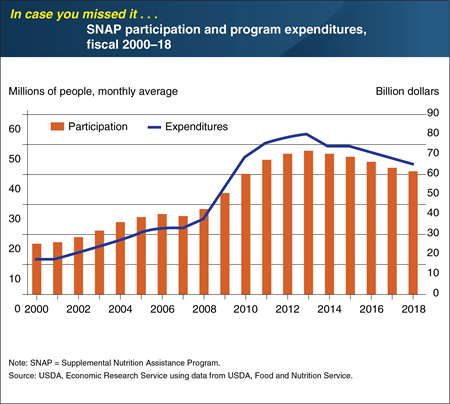
Tuesday, December 17, 2019
The Supplemental Nutrition Assistance Program (SNAP) is the cornerstone of USDA’s food and nutrition assistance programs, accounting for 68 percent of all Federal food and nutrition assistance spending in fiscal 2018. An average of 40.3 million people per month participated in the program in fiscal 2018, 4 percent fewer than in fiscal 2017. As the fifth consecutive year of declining participation, fiscal 2018’s caseload was 15 percent less than the historical high average of 47.6 million participants per month in fiscal 2013. The decrease in SNAP participation in 2018 was likely associated with the country’s continued economic improvement in recent years. Federal spending for SNAP fell by 5 percent in fiscal 2018 to $65.0 billion—19 percent less than the historical high of $79.9 billion set in fiscal 2013. This chart appears in the ERS report, The Food Assistance Landscape: FY 2018 Annual Report, released on April 18, 2019. This Chart of Note was originally published May 7, 2019.
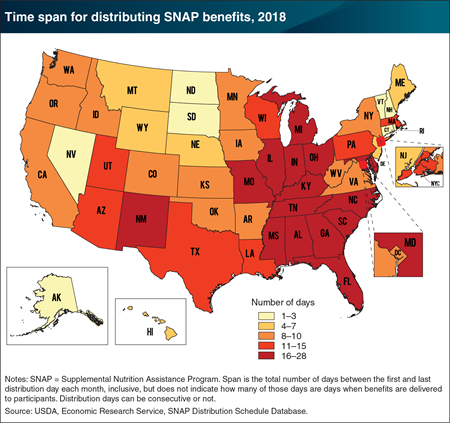
Friday, November 8, 2019
Households participating in USDA’s Supplemental Nutrition Assistance Program (SNAP) receive their benefits in a lump-sum on a single day each month. The majority of benefits are redeemed within a week after households receive them. When benefits are distributed on a single day or over a few days each month, this can produce a surge in demand, followed by a large drop in demand—making it difficult for food retailers to adequately stock and staff stores throughout the month. States have the option to stagger benefit deliveries over the month, with a portion of SNAP recipients receiving benefits each distribution day. These distribution days can be consecutive or not. Benefit distribution schedules differ by State, and many have changed over time. A new ERS database documents monthly distribution schedules for each State, the District of Columbia, and New York City for 1998–2018. The number of States that distribute SNAP over 16 days or more each month has increased from 2 States in 1998 to 16 States in 2018. Most of the States with the longest span in their SNAP distribution schedule are in the South and Midwest. This map appears in the August 2019 Amber Waves article, “ERS’s SNAP Distribution Schedule Database Allows for New Research on Program Impacts.”
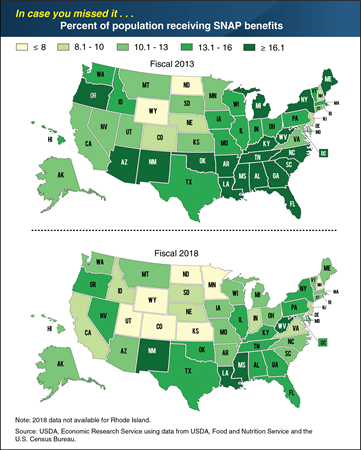
Tuesday, November 5, 2019
USDA’s Supplemental Nutrition Assistance Program (SNAP) provides benefits for purchasing food in authorized food stores to needy households with limited incomes and assets. In fiscal 2018, an average of 40.3 million low-income individuals per month received SNAP benefits in the United States. The percent of Americans participating in the program declined from 15.0 percent in 2013 to 12.3 percent in 2018, marking the fifth consecutive year of a decline in the percent of the population receiving SNAP. In seven States—Colorado, Kansas, Minnesota, New Hampshire, North Dakota, Utah, and Wyoming—8 percent or fewer of residents received SNAP benefits in 2018. Between 2013 and 2018, 46 States and the District of Columbia saw a decrease in the share of residents receiving SNAP benefits, while 4 States experienced increases. Idaho showed the largest decline in percent of residents participating in SNAP—a 36-percent decline from 14.1 to 9.0 percent of residents. Eighteen States and the District of Columbia had declines in participation shares of at least 25 percent between 2013 and 2018. Nevada had the largest increase in participation share, growing from 12.9 to 14.5 percent of residents. The fiscal 2018 map appears in the "Food Security and Nutrition Assistance" section of the ERS data product, “Ag and Food Statistics: Charting the Essentials,” updated in June 2019. This Chart of Note was originally published July 18, 2019.

Wednesday, October 9, 2019
As participants in USDA’s Supplemental Nutrition Assistance Program (SNAP) spend their benefits, income is generated for those involved in producing, transporting, and marketing the food and other goods purchased by SNAP recipients. ERS researchers recently compiled a new social accounting matrix to quantify the effect of additional SNAP benefits on employment and gross domestic income (GDI) for various sectors of the U.S. economy. They found that a hypothetical new $1 billion in SNAP benefits would have a relatively large effect on manufacturing industries and the trade and transportation industries. The new SNAP benefits would generate $218 million in GDI and 1,540 full-time equivalent jobs for manufacturing industries, including food and beverage processors. For the trade and transportation industries, new income totaling $406 million and 4,450 jobs would be generated. These industries include grocery stores, food and other wholesalers, plus the trucking and rail freight industries, among others. The hypothetical new $1 billion in SNAP benefits would generate an additional $32 million in GDI going to agriculture, forestry, fishing, and hunting and 480 jobs in these industries. This chart appears in the ERS report, The Supplemental Nutrition Assistance Program (SNAP) and the Economy: New Estimates of the SNAP Multiplier, and the Amber Waves article, “Quantifying the Impact of SNAP Benefits on the U.S. Economy and Jobs,” released in July 2019.

Friday, September 13, 2019
In an average month in fiscal 2018, USDA’s Supplemental Nutrition Assistance Program (SNAP) provided 40.3 million low-income Americans with benefits to purchase food at authorized food stores. In fiscal 2017 (the latest year for which demographic data are available), adults aged 18–59 accounted for 43.4 percent of participants, children younger than age 5 accounted for 13.4 percent of participants, school-age children accounted for 30.0 percent of participants, and adults aged 60 and older accounted for 13.1 percent of participants. The composition of SNAP participants can be affected by changing economic conditions, modifications to program requirements, and demographic trends. Over the last decade, children’s share of the SNAP caseload has fallen from 49.1 percent in fiscal 2007 to 43.4 percent in fiscal 2017. The share of SNAP participants who are age 60 or older has risen from 8.7 to 13.1 percent over this period. The second chart appears in the Food Security and Nutrition Assistance section of the ERS data product, Ag and Food Statistics: Charting the Essentials.
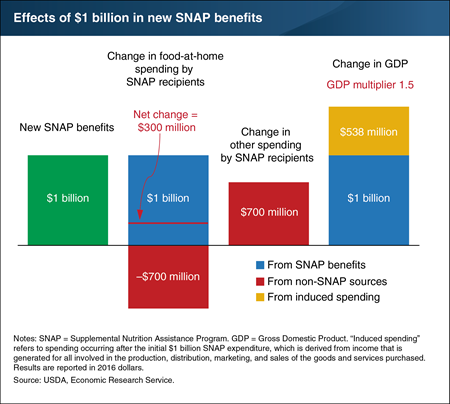
Wednesday, August 21, 2019
Low-income participants in USDA’s Supplemental Nutrition Assistance Program (SNAP) generally spend their benefits soon after receiving them. This spending by SNAP households “multiplies” throughout the U.S. economy as the businesses supplying the food and other goods purchased—and their employees—receive additional funds to make purchases of their own. A recent ERS study examined the multiplier effect of a hypothetical $1 billion increase in SNAP benefits. Most SNAP participants spend their own cash in addition to SNAP benefits to purchase adequate food. Thus, SNAP households would spend the full amount of the increased benefits, but would redirect some of the cash that they were spending on food at grocery stores to other goods or services. The study predicted that the $1 billion in additional SNAP benefits would raise SNAP households’ food spending by $300 million and their non-food spending by $700 million. This increased spending, combined with the subsequent multiplier-induced spending of both non-SNAP households and SNAP households ($538 million), would raise Gross Domestic Product (GDP) by $1.54 billion. This chart appears in the ERS report, The Supplemental Nutrition Assistance Program (SNAP) and the Economy: New Estimates of the SNAP Multiplier, and the Amber Waves article, “Quantifying the Impact of SNAP Benefits on the U.S. Economy and Jobs,” released July 18, 2019.
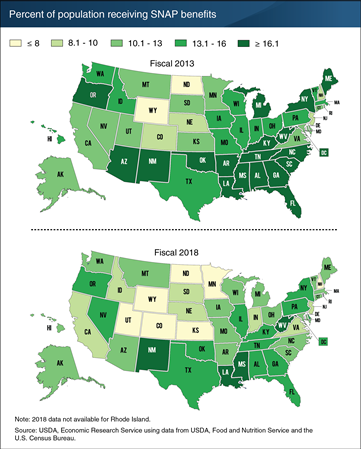
Thursday, July 18, 2019
USDA’s Supplemental Nutrition Assistance Program (SNAP) provides benefits for purchasing food in authorized food stores to needy households with limited incomes and assets. In fiscal 2018, an average of 40.3 million low-income individuals per month received SNAP benefits in the United States. The percent of Americans participating in the program declined from 15.0 percent in 2013 to 12.3 percent in 2018, marking the fifth consecutive year of a decline in the percent of the population receiving SNAP. In seven States—Colorado, Kansas, Minnesota, New Hampshire, North Dakota, Utah, and Wyoming—8 percent or fewer of residents received SNAP benefits in 2018. Between 2013 and 2018, 46 States and the District of Columbia saw a decrease in the share of residents receiving SNAP benefits, while 4 States experienced increases. Idaho showed the largest decline in percent of residents participating in SNAP—a 36-percent decline from 14.1 to 9.0 percent of residents. Eighteen States and the District of Columbia had declines in participation shares of at least 25 percent between 2013 and 2018. Nevada had the largest increase in participation share, growing from 12.9 to 14.5 percent of residents. The fiscal 2018 map appears in the Food Security and Nutrition Assistance section of the ERS data product “Ag and Food Statistics: Charting the Essentials,” updated in June 2019.

Tuesday, June 4, 2019
USDA’s Supplemental Nutrition Assistance Program (SNAP) is the Nation’s largest food assistance program. In an average month in fiscal 2018, 40.3 million people—about 12 percent of the Nation’s population—participated in the program, receiving benefits averaging $125.25 per person per month. The share of the Nation’s population participating in SNAP grew from 6 percent in 2000 to approximately 9 percent in 2007, and then increased more sharply to just under 11 percent in 2009 as economic conditions deteriorated during the Great Recession, which officially lasted from December 2007 to June 2009. The share of the population receiving SNAP benefits continued to rise as labor market conditions in low-wage occupations remained weak and poverty rates remained high after the Great Recession’s official end. Policies to increase program access and temporarily increase benefit levels also likely encouraged eligible people to enroll in SNAP. By 2013, 15 percent of the U.S. population participated in the program each month. From 2014 to 2018, the share of the population enrolled in SNAP fell each year as economic conditions improved. This chart appears in the ERS report, The Food Assistance Landscape: FY 2018 Annual Report, April 2019.
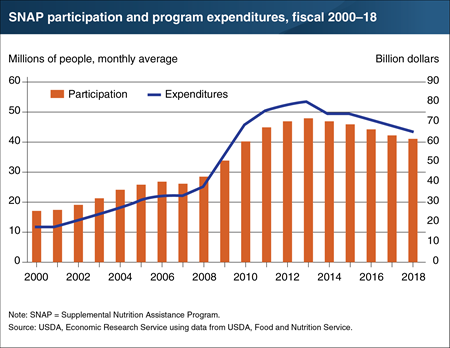
Tuesday, May 7, 2019
The Supplemental Nutrition Assistance Program (SNAP) is the cornerstone of USDA’s food and nutrition assistance programs, accounting for 68 percent of all Federal food and nutrition assistance spending in fiscal 2018. An average of 40.3 million people per month participated in the program in fiscal 2018, 4 percent fewer than in fiscal 2017. As the fifth consecutive year of declining participation, fiscal 2018’s caseload was 15 percent less than the historical high average of 47.6 million participants per month in fiscal 2013. The decrease in SNAP participation in 2018 was likely associated with the country’s continued economic improvement in recent years. Federal spending for SNAP fell by 5 percent in fiscal 2018 to $65.0 billion—19 percent less than the historical high of $79.9 billion set in fiscal 2013. This chart appears in the ERS report, The Food Assistance Landscape: FY 2018 Annual Report, released on April 18, 2019.
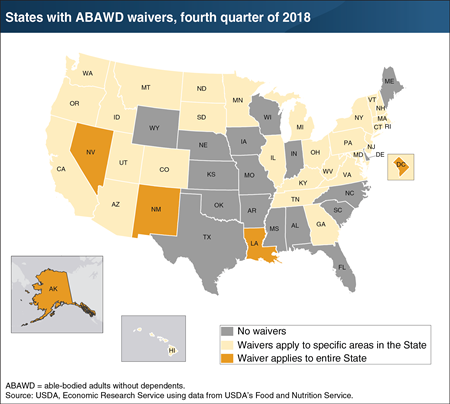
Tuesday, February 26, 2019
Signed into law December 20, 2018, the Agriculture Improvement Act of 2018 (2018 Farm Act) reauthorized USDA’s Supplemental Nutrition Assistance Program (SNAP), the Nation’s largest food assistance program, through fiscal 2023. Although the program’s eligibility guidelines and work requirements were a major focus of legislative debate, they were not changed in the final legislation. Under current rules, working-age SNAP recipients, with some exceptions, must register for work and accept a suitable job if offered. In addition, able-bodied adults ages 18-49 with no dependents (ABAWDs) who work less than 20 hours a week can receive SNAP benefits for only 3 months out of every 3 years. States can request from USDA a waiver of this time limit in locations where unemployment rates are high or jobs are insufficient, as measured by a limited set of economic indicators. As of December 2018, four States (Alaska, Louisiana, Nevada, and New Mexico)—along with the District of Columbia, Guam, and the Virgin Islands—had received USDA approval to waive the time limit on ABAWDs receiving SNAP benefits. Another 29 States had ABAWD time limit waivers in specific locations, and 17 States were enforcing the limit. USDA proposed new rules, published in the Federal Register on February 1, 2019, to tighten the conditions under which States could be approved to implement ABAWD waivers. This chart appears in the Nutrition Title section of The Agriculture Improvement Act of 2018: Highlights and Implications, produced by ERS researchers.

Thursday, October 18, 2018
A recent ERS study examined the responsiveness of participants in USDA’s Supplemental Nutrition Assistance Program (SNAP) to changes in local labor market conditions. The researchers used SNAP administrative records from Oregon to estimate the likelihood of nondisabled, or able-bodied, working-age people leaving SNAP as local labor market conditions improve. Favorable labor market conditions were more likely to lead to SNAP exits when labor market areas were defined as commuting zones, a definition that explicitly tries to capture areas where people live and work. In Oregon commuting zones, a 10-percent increase in the number of people employed was estimated to raise the likelihood that the average able-bodied, working-age (ages 25-59) SNAP participant left the program within a year by 8.7 percent, and a 10-percent increase in local new hires was estimated to raise the likelihood of leaving SNAP by 1.5 percent. Defining the local labor market area to coincide with Oregon counties, rather than commuting zones, resulted in smaller—but still positive—estimated effects. This chart appears in “Local Labor Market Conditions Impact Participation in USDA’s Supplemental Nutrition Assistance Program” in ERS’s Amber Waves magazine, September 2018.
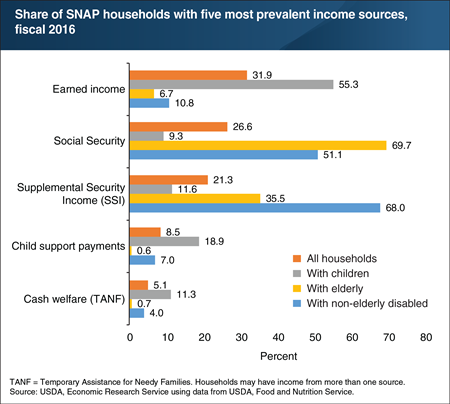
Tuesday, October 2, 2018
In a typical month in fiscal 2017, USDA’s Supplemental Nutrition Assistance Program (SNAP) provided average monthly benefits of $126 per person to 42.1 million low-income people living in 20.9 million households. SNAP households report receiving income from a variety of sources. The most prevalent income source is earnings, which were received by 32 percent of SNAP households in fiscal 2016. Social Security benefits were received by 27 percent of all SNAP households and 70 percent of those with elderly members. Supplemental Security Income (SSI), a cash assistance program designed to help low-income non-elderly disabled and elderly people, was received by 21 percent of all SNAP households, 68 percent of SNAP households with non-elderly disabled members, and 36 percent of those with elderly members. Around 9 percent of all SNAP households and 19 percent of those with children received child support payments. In 2016, 5 percent of all SNAP households and 11 percent of those with children received cash assistance from Temporary Assistance for Needy Families (TANF). SNAP households may also receive non-cash assistance such as housing vouchers and free or low-cost health care coverage. This chart is from the Supplemental Nutrition Assistance Program (SNAP) topic page on the ERS website.
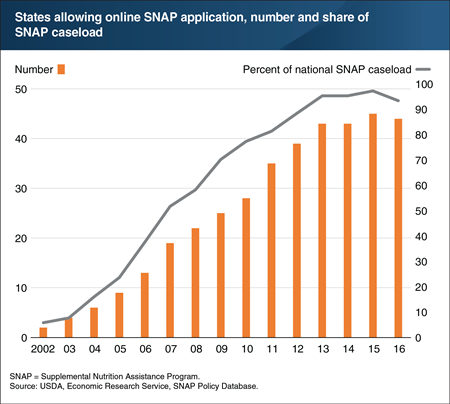
Tuesday, September 18, 2018
The Supplemental Nutrition Assistance Program (SNAP) is the largest of USDA’s 15 food and nutrition assistance programs, providing monthly benefits for purchasing food to those who apply for the program and meet the income and other eligibility criteria. In fiscal 2017, 42.1 million Americans were enrolled in the program during an average month. ERS’s SNAP Policy Database provides information on policies in the 50 States and the District of Columbia that may affect SNAP participation. For example, online applications allow individuals to complete and submit an application for SNAP benefits over the Internet. Applicants then undergo an interview at the SNAP office or over the phone to complete the application process. Online applications first became available in January 2002 and were offered in 44 States by December 2016. Although not all SNAP applicants use the online option, a high percentage of the SNAP caseload resides in States where it is available. The 44 States that provided online applications accounted for 93 percent of the national SNAP caseload in 2016. The monthly State-level information contained in the database can facilitate research on factors that may have an effect on SNAP participation and the program’s impacts. The information for this chart can be found in ERS’s SNAP Policy Database.
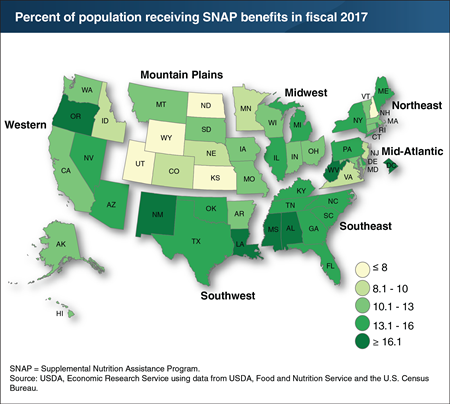
Friday, September 14, 2018
The Supplemental Nutrition Assistance Program (SNAP)—USDA’s largest food assistance program—provided assistance to 42 million low-income individuals in the United States in 2017. These individuals accounted for 12.9 percent of the U.S. population, down from 13.7 percent in 2016. The share of Americans participating in SNAP has declined each year since 15.1 percent participated in 2013. In 2017, the State shares of residents receiving SNAP benefits ranged from 22.1 percent in New Mexico to 5.7 percent in Wyoming. Differences in the State shares reflect differences in economic conditions, need, and program policies. Among seven FNS-defined regions nationwide, in 2017, the Southeast region had the highest average share of residents receiving SNAP benefits at 15.1 percent, and the Mountain Plains region had the lowest average share of residents receiving SNAP at 9.6 percent. This chart appears in “Participation in SNAP Varies Across States But Is Generally Decreasing” in the September 2018 issue of ERS’s Amber Waves magazine.

Monday, July 23, 2018
USDA administers 15 domestic food and nutrition assistance programs that together form a nutritional safety net for millions of children and low-income adults. Federal spending on these programs totaled $98.6 billion in fiscal 2017, 4 percent less than the previous fiscal year and almost 10 percent less than the historical high of $109.2 billion set in fiscal 2013. Fiscal 2017’s decline was likely largely due to continued growth in the U.S. economy. Spending for the Supplemental Nutrition Assistance Program (SNAP), which accounted for 69 percent of Federal food and nutrition assistance spending in fiscal 2017, totaled $68.0 billion, or 4 percent less than in fiscal 2016 and 15 percent less than the historical high of $79.9 billion set in fiscal 2013. Spending on the Special Supplemental Nutrition Program for Women, Infants, and Children (WIC) fell to $5.6 billion in fiscal 2017, 6 percent less than in fiscal 2016. Spending on the three largest child nutrition programs—the National School Lunch Program, the School Breakfast Program, and the Child and Adult Care Food Program—remained about the same. This chart appears in ERS’s data product, Ag and Food Statistics: Charting the Essentials.

Tuesday, June 12, 2018
In fiscal 2016, 44.1 percent of the 43.5 million Americans participating in USDA’s Supplemental Nutrition Assistance Program (SNAP) were children, 44.1 percent were working-age adults, and 11.8 percent were elderly. The age composition of SNAP participants varies over time in response to economic conditions, legislative modifications, and demographic trends. Job losses that accompanied the 2007-09 recession and the slow recovery resulted in more working-age adults (ages 18-59) becoming eligible for SNAP benefits and seeking assistance. Legislation enacted in 2009 that waived time limits on benefits and work requirements for able-bodied adults without dependents further expanded the number of working-age participants. Working-age adults’ share of the SNAP caseload rose from 42.4 percent in 2007 to a peak of 46.5 percent in 2012, and then fell to 44.1 percent by 2016 as the economy improved and benefit time limits were reimposed in parts of most States. Children under age 5 have become a smaller share of SNAP participants, indicative of the decline in the number of U.S. births. The share of SNAP participants who are elderly (age 60 or older) has risen in recent years, reflecting the aging U.S. population, greater outreach to the elderly, and a simplified SNAP application process. This chart is from “Age Composition of USDA’s SNAP Caseload Shifts in Response to Economic Conditions, Legislation, and Demographic Trends”in ERS’s June 2018 Amber Waves magazine.
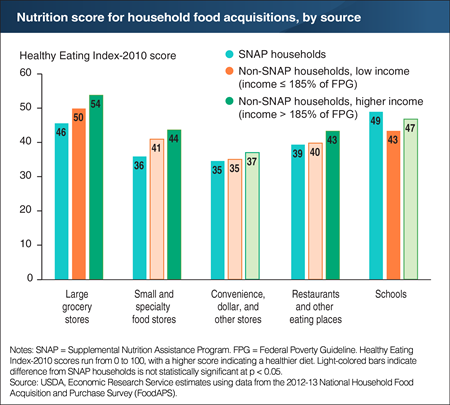
Wednesday, May 9, 2018
Using data from USDA’s National Household Food Acquisition and Purchase Survey (FoodAPS), ERS researchers calculated nutrition scores for foods purchased or acquired for free by three groups: participants in USDA’s Supplemental Nutrition Assistance Program (SNAP), low-income non-SNAP households, and higher income non-SNAP households. For the scores, the researchers used the Healthy Eating Index-2010, which is a measure of dietary quality that assesses conformance to the 2010 Dietary Guidelines for Americans. Scores run from 0 to 100 and summarize how well the week’s foods compare to Federal dietary recommendations—a higher score reflects a healthier diet. Foods acquired at large grocery stores were more nutritious than foods from smaller stores or from restaurants and other eating places. However, grocery store purchases by SNAP households scored 4 and 8 points below purchases by low-income and higher income non-SNAP households, respectively. For SNAP households, school food rivaled large grocery stores for nutritional quality. This is likely because meals served as part of USDA’s school lunch and breakfast programs must meet Federal nutrition standards. SNAP participants are eligible for free or reduced-price school meals and likely rely more on these meals and less on snacks and other items sold in schools that are not required to meet the same nutrition standards as USDA school meals. A version of this chart appears in the February 2018 Amber Waves article, "Supermarkets, Schools, and Social Gatherings: Where Supplemental Nutrition Assistance Program and Other U.S. Households Acquire Their Foods Correlates With Nutritional Quality."


